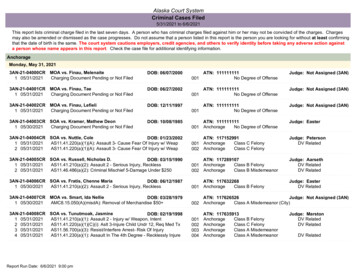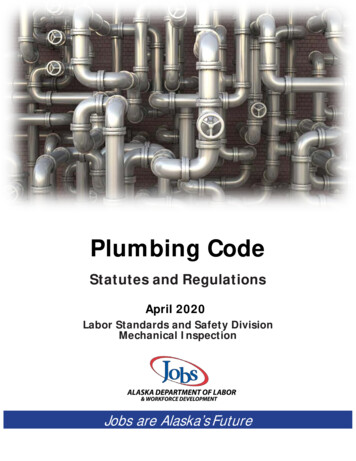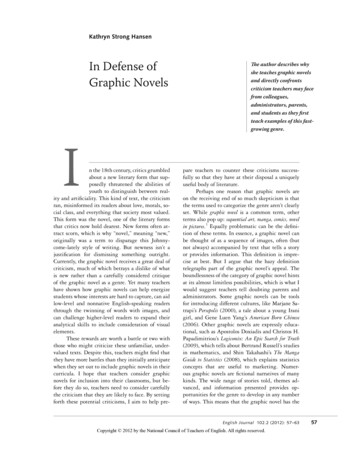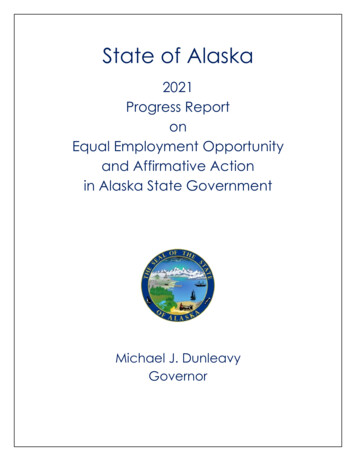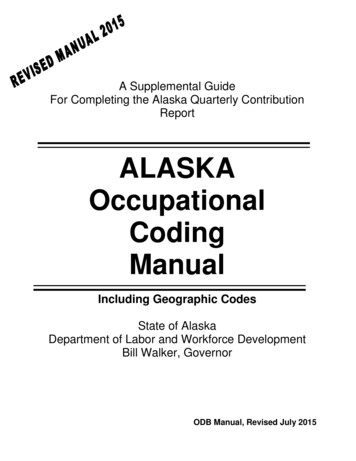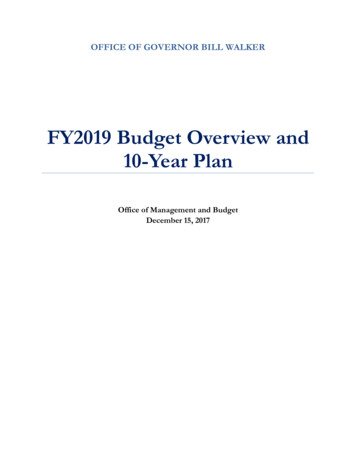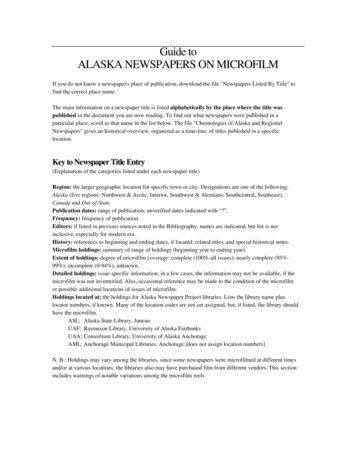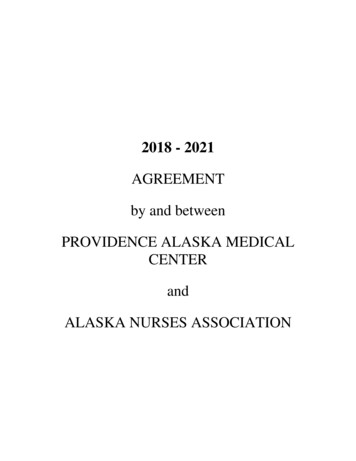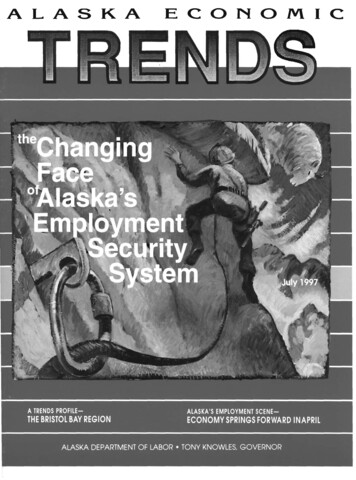
Transcription
ALASKA ECONOMIC\laska Economic Trends is a nlonthly publicationlealingwith a varlety ofeconomic-related issuesin thetate.\laska Economic Trendsis funded by the Employment ecurity Division and p blishedby the Alaskakpartmentof Labor, P.O. Box 21 149, Juneau,Alaska19802-1149. For more information, call the DOL'ublications Office at (907) 465-6019 or enmil the ithors.daterial in this publication is public information and,vith appropriate credit, may be reproduced without ermission.iditor's Note: Theviews presented in guest articles in4laska Econon icTrendsdo not necessarily reflect theThe Changing Face ofAlaska's Employment Security SystemA Trends ProfileThe Bristol Bay RegionEconomy Springs Forward in AprilEmployment Scene Tables:22Nonagricultural Wage and SalaryEmployment-Alaska and Anchorage22Hours and Earnings forSelected Industries23Nonagricultural Wage and SalaryEmployment in Other Economic Regions24Unemployment Rates byRegion and Census AreaPrmted and drstrrbuted byA SETSI:a vocatronal traiainmgcenter and employmentprogramThis publication, funded by theDepartmm of t a b r ' s EmploymentSecurity Dlv sron,was produced ata cmt ai .84 p c r copyCover design by Jim Fowler---
The mi pace of Alaska'sby Corine Celdhof1n the world of work today, the alliance betweenworkers and employers is radically changing,and so is the business of linking job seekers topotential employers. Linking employers to workers and workers to jobs is the business of laborexchange. Labor exchange, beyond paying unemployment insurance benefits to the tens ofthousands of Alaskan workers temporarily laidoff each year, has been the role of the AlaskaDepartment of Labor's (AKDOL) EmploymentSecurity Division for 60 years.How these once simple transactions of connecting job seekers and employers and paying benefits to the temporarily unemployed w i l l configurein the future i s the most recent challenge ofAlaska's employment security system. Government, not unlike most industries, faces the challenge as a paradox: how to deliver more servicesat less cost.Anchorage, Fairbanks, Juneau, and Ketchikan in1937 were the sites of the territory's first publicemployment offices.Since 1937, the Alaska Employment Service hasbeen the state's primary labor exchange - dedicated to bringing employers and qualified jobseekers together. Nearly 25 percent of Alaska'sworking age population relies on public employment service programs to help secure employment. Last year, over 28,000 jobs in a broadrange of occupations at various wage and salarylevels were filled through the public employmentservice, and thousands of other job seekers foundstop-gap employment to tide them over untiltheir job prospects improved. More than 6,000of Alaska's employers use the state's employment service each year, posting over 30,000 jobopenings. The program operates 19 local officesin communities from Ketchikan to Nome. Thegoal is to contribute to the economic stability ofAlaska by making sure Alaska's workers get helpwhile unemployed and assistance for findingjobs.Alaska'semployment security system, comprisedofthe Alaska Employment Serviceand the Unemployment Insurance program, i s forging into the21st century by taking advantage of numeroustechnological advancements and realigning itsorganizational framework to face this challenge.It is doing so under a statutory requirement thatdefines AKDOL's mission to "foster and promotethe welfare of the wage earners of the state,improve their working conditions, and advancetheir opportunities for profitable employment,"(Alaska Statute 23.05.1 01).Much of what works in Alaska's public employment service comes from having to respond to thefluctuationsin the state's highly variable econoAlaska's Employment Servicemy. A strong seasonal demand for labor fromhistorically accessible statewideindustries such as tourism, timber, fishing, seaThe crisis of the Great Depression that put hun- food processing, oil exploration and production,dreds of thousands out of work in the 1930's construction, mining, and manufacturing createsinduced the federal government to pass laws to the necessity for an integrated mix of services forprevent or remedy future social ills. The Wagner- employers and job seekers alike. The employPeyser Act of 1933 established nationwide, gov- ment service does this b y delivering services thaternment-run employment offices, and in Alaska, best respond to the needs of Alaska's employers,what is now known as the Alaska Employment wherever they happen to be, for competent andService. The four main industrial centers of available workers, wherever they happen to be.Corine Geldhof isthe CommunicationsCoordinator at theEmploymentSecurity Division,Alaska Departmentof Labor. Corine islocated in Juneau.The Alaska Employment Servicehas been the state's primarylabor exchangeAlaska Economic Trends July 19971
Alaska Employment Service offices are involvedin a progressive "re-employment" program forunemployment insurance recipients, where people are assessed and offered extensive servicesintended to hasten their return to employment.Focus is on returning people to work and providing them with the requisite skills. A recent andhighly successful innovation to the Alaska EmToday, more often than not, the Alaska Employ- ployment Service is the job club, a self-supportment Service office is the "town center," serving ed, peer-oriented group where job seekers conasfiinformationagents," particularly in rural towns. vene weekly to network and help each otherAlaska Employment Service is the office where infiltrate the labor market, giving each otheradvice on resumes, interviewing tips, and jobsearching.Linkages occur through many channels, including within employer communities, native corporations, chambers of commerce, schools, universities, community colleges, economic development councils, labor unions, and other employers and organized worker groups throughout thestate.Today the Alaska EmploymentService office is the "towncenter," serving as "informationagents," particularly in ruraltowns.those seekingto set up businessopportunities go;the place where those who need immediateassistance during Alaska's many seasonal employment cycles go; the place where employersin search of local labor market information go;and the place where employers who need toconduct job interviews in customized interviewing space, called "Employer Stores," go. Selfservice computer resource rooms offer the visiting public computers to write resumes, obtainlabor market information, look for jobs, make anappointment with an employer, explore trainingopportunities, and acquire career information.The public employment service and its agencypartners are on the scene with what in the tradeis referred to as a "rapid response" effort whenmills close, school teachers are laid off, and bigoil companies announce downsizing. In the communities of Wrangell and Sitka, and most recently Ketchikan, where an overwhelming percentage of the labor force was devastated by millclosures, the employment security system responded by establishing on-site "transition centers" for direct support to laid-off workers andtheir families.Another high-profile initiative of the public employment security system today is Alaska Hire.Many of Alaska's top industries, including seafood processing, hire from Outside. The Employment Service has targeted the seafood industry asan area to promote year-round employment forresident hire by establishing a specialized seafood unit whose primary mission is to work withAlaska's seafood industry processors. The aim i sto build partnerships that will provide a stableworkforce for processors, with an emphasis onthe employment of Alaskans into quality, yearround jobs. The collaboration and partnershipappear to be paying off. Of those newly hired inthe summer seafood industry, about 25 percentin 1996 were Alaska Permanent Fund Dividendrecipients (residents)compared to only about 19percent in 1995.Unem loyment Insurance Programroote in territorial AlaskaBThe federal Social Security Act that gave us unemployment insurance was passed in 1935. Alaskafollowed suit in 1937 when the territorial legislatureenacted the Alaska Employment Security Actbecause lawmakers deemed ".involuntary unemployment is a serious menace to the health,morale, and welfare of the people of the state."According to the territorial commission's firstannual report to the Governor, "The territory hasnever undertaken a program presenting greateradministrativedifficultiesand responsibilitiesthanthose imposed by the Unemployment Compen-
heand signed by hand in Alaska for 1 0.60, issuedU I program is counter cyclical, making itpossibleto accumulate reserves during goodJanuary 24, 1939. Since then, Alaska has paidbillions of dollars in benefits, 1.3 billion be- economic times in order to meet drains on the U ITrust Fund in poorer years. It is one of the builttween 1987 and 1996 alone.in stabilizers in the economy, going into effectimmediately with the onset of economic decline.What does UnemploymentFor employers from whom the majority of FUTAInsurance do?taxes are collected, a sound state unemploymentUnemployment insurance (UI) is an insurance tax structure provides an incentive to maintainprogram, not a welfare program. It is insurance stable employment and a method for buildingfor people who would work if they could find a reserves during periods of economic growth thatjob. Among the most important things people in can be utilized during periods of economic desearch of work need is financial support to tide cline.them over between jobs, and UI is designed to dojust that. As with other forms of insurance, whenthe benefits are needed they providevital supportto the recipients. For employers, U I benefitsmean that a trained workforce is more likely toremain in the local communityduring temporaryor even seasonal layoffs. During the recessionbetween 1985 and 1988 in Alaska, more than138,000 unemployed workers received unemployment compensation totaling over 578 million. If the UI system's benefits were consideredpayroll during that time, the system would havebeen the third largest employer in the state. Inaddition, in times of economic trouble, an infusion of spendable income preserves the health oflocal economies. Nearly every dollar paid inunemployment benefits returns immediately tolocal communities.People in search of work needfinancial support to tide themover between jobs, and UI isdesigned to do just that.Benefits are only available to those persons whohave worked and are temporarily unemployed.There isa limit to benefits that can beclaimed. Bylaw, unemployed workers must meet certainrequirements to receive unemployment checks.They must be actively seeking work and ready,able, and willing to immediately accept work forwhich they are reasonably suited. The amount ofbenefits a worker may receive each week i sdetermined by past wage experience. The numHow are UI Benefitsber of weeks a person w i l l be eligible is detercalculated and for whom?mined by the length and stability of that person'sThe Alaska U I program is governed by the Alaska work history. In these ways, UI eligibility reflectsa recipient's demonstrated attachment to theEmployment Security Act. Taxes from both employers and workers in the state are collected to labor force.fund the payment of unemployment benefits.Alaska is one of only three states where theWhere the system goes fromemployer and the worker share the responsibilityhere is the 21st century challengefor building the reserves from which unemployment benefits are paid. Employers pay an addi- H o w a system steeped in purposeful traditiontional tax to fund administration of the program prepares itself to face the future where workersunderthe Federal UnemploymentTax Act (FUTA). and employers will have needs far different fromThe Employment Security Tax Section of Employ- those at its inception 60 years ago i s the parament Security Division collects more than 1 35 mount consideration in restructuring public emmillion yearly to pay more than 70,000 individ- ployment security services. Meeting those needswill become important as the demand for skilleduals.---Alaska Economic Trends July 1997- -3
labor grows. According to the November 13,1996, issue of the Employment and TrainingReporter, from January 1 993 through July 1996,the nation's economy added 10.2 million jobs,while at the same time 8.4 million people weredisplaced from theirjobs. Two-thirdsofthe newjobs created demand higher than average skillsand pay an above average salary. Although as ofthis writing no conclusive data exist about similar trends in Alaska, there is little doubt that thedemand for skilled labor will be no exception asAlaska's economy gears up to face the nextcentury.Any employment security program of the futureinevitably w i l l involve the use of technology.New information systems and technologies arewhat Associate Assistant Secretary for the U S .Department of Labor, JimVol lman, says are the"electronic backbone for the American workforce development system." This application isparticularly useful in Alaska. The state employment security programs are federally fundedand statutorily required to provide a host ofservices to Alaska's over 600,000 citizens whooccupy nearly 600,000 square miles. The statehas much to gain from technological advances,more perhaps than any other area of the US.,due tothevast distancesoverwhich itsdisparateand sparse population is spread, and due to itssevere climate.New nformation 'ystems andtech ogiesare the "electronickbone for the Americanworkforce developmentsystem "Futurists predict that within the next decade upto 50 percent of the United States' workforcecould be self-employed. How employers willfind workers, how job seekers will find work,and how, meanwhile, unemployment benefits4are dispersed to the eligible unemployed arequestions for which Alaska's Employment Security Division isin a race with theclock toanswer.Peter Calderone, the former commissioner forNew Jersey's Department of Labor remarkedwhen speaking on behalf of his own efforts toreorganize New Jersey's system, "In today's fastpaced world, it's more than ever true that thosewho hesitate are lost."Future labor exchange requiresrealignment and transformationAlaska'swake-upcall in recognizingthe need toexpedite its future labor exchange was prompted by a 1996 federal reduction of nearly 1million in Wagner-Peyser funds used to pay forstateemployment service programs. Theamountof nearly 1 million represented approximately1 0 percent of Alaska's public employment serviceannual operating budget. Although theonuswas on the employment service component ofthe budget, the cut was severe enough to realignand transform the entire operations, includingthe unemployment insurance (UI) program. Theoperating costs for both the UI and employmentservice programs are almost 100 percent federally funded in Alaska. A critical link existsbetween the two programs because a quickreturn to employment restores workers' earningsand minimizes unemployment benefitspaidfrom employer taxes. Under the existing 60year-old system, unemployment benefit recipients are required to register and report for emdovment services: in order to receive benefits.they must be able to actively look for work.81As a result of the federal budget reductions, theAKDOL Employment Security Division's taskthis past year has been to restore productivityand deliver fast, efficient services and highdemand products. A new look at the histori;alcore mission and institutional purpose of Alaska's employment security system provides direction to this task--get people jobs and pay UI.clearly, the immediate challenge is to enhancetheirdeliven/, and theanswer has been found inemerging technologies.Alaska Economic Trends July 1997
UI "Call Centersu--where telephonelines replace waiting linesProcessing U I claims is a straightforward, standardized procedure and does not require oneon-one, labor-intensivecontact between aclaimstaker and a claimant. When seasonal high unemployment hits communities, staff time typicallydevoted to employment services, such as jobsearches and employer outreach, stands still inthe employment service offices across Alaskauntil UI is processed, one-on-one, claim by claim.Ironically, when there is high unemployment,there is a more pressing need to help the unemployed find or prepare to find their next job, inaddition to paying benefits. Organizationalchange has been inspired by the thought that UIclaimants just want the services provided to themas efficiently as possible.In November 1995, when seasonal highs inprocessing unemployment claims paralyzed theemployment service side of operations, the largest office in Anchorage converted to a UI "callcenter," no longer requiring claimants to file forbenefits in person. Claims were taken by mail orphone only. For Anchorage, which annuallyhandles 24 percent of the state's claims, thetransition changed the look and feel of the localoffice. "Before this, the office was focused onunemployment claims, with seasonal peaks thatwould feel like chaos," said Jerry Kanago, Anchorage Office Manager. "We reduced the number of in-office customers, which reduced waiting time. N o w our face-to-face customers are jobseekers, actively choosing our services to findnew jobs."Sitka's local office manager of the Alaska Employment Service, found time to canvass the community's employers. "Our plan was to introduce ouremployment services to a host of new customers.We said, 'We are your job service; we're here toserve you; what can we do?'" The results wereextraordinary, including immediately receivingfive times as many job orders in a two-weekperiod from Sitka's employer community. "Taking unemployment processing out of the officehas changed our focus. We are now directing ourtime to employers, which is where I alwaysbelieved it should be, but we could never findenough time," Scott added.Toll-free call centers areenabling Alaskans from all overthe state to initiate their UIclaims.The Sitka local office of the Alaska EmploymentService has long been known for its professional,business-like environment, but one significantchange was made recently, to increase the customer focus. "We had this counter in our reception area, a barrier between us and our customers," Scott said. "We took it down. N o w wewelcome our customers face-to-face, eye-to-eye."Predicated on the success of the Anchorage experiment, toll-free call centers today are enablingAlaskansfrom all over the state to initiate their UIThe lobby area in Anchorage once used for claims. The efficiencies i n Anchorage showedwaiting, was converted to a resource room with that the physical and functional removal of UIpersonal computers and self-service terminals. from the employment service office was not onlyCustomers can prepare resumes, review current logical, it made good "service" sense. Telephonejob openings, obtain labor market information lines replaced waiting lines for the unemployed.and refer themselves to a job club facilitated by Moreover, staff overtime has decreased as mucha staff member, Job club participants work as a as 96% in some locations, and call center staffgroup for three weeks, networking, sharing em- report very favorable feedback from users. Beployer information, practicing interviews and fore the call centers, Alaska paid only 79 percentof UI claimants on a timely basis, but with thereviewing each other's resumes.advent of new processing, over 90 percent areWhen the effect of centralizing UI claims into now on time."call centers" began to be felt, John Scott, thenAlaska Economic Trends July 19975
With the passage of the Social SecurityAct of 1935, the Unemployment InsuranceSystem was born.Seattle liaison branch closed. Allowance fordependents was added to benefits.Nome office opened.April 1951, Wrangell office transferred toPetersburg.
Alaska's Employment Security System A Trends Profile- . best respond to the needs of Alaska's employers, wherever they happen to be, for competent and . payroll during that time, the system would have been the third largest employer in the state. In addition, in times of economic trouble, an infu- .

